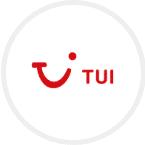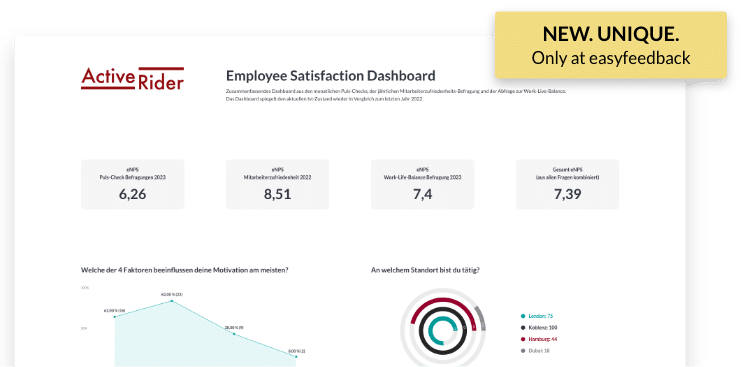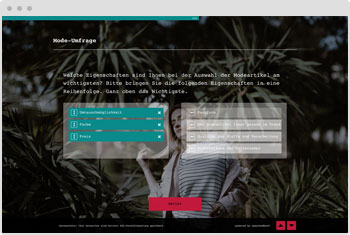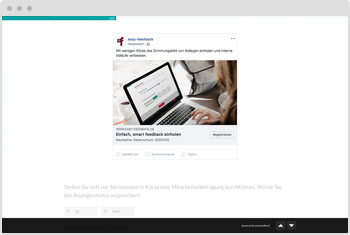Have products evaluated for quality & handling with product feedback & tests

Regular product evaluations via questionnaire can provide you with valuable product development insights before as well as after launch.

“Identifying customer needs is an essential part of our business. easyfeedback accompanies us for many years as a loyal partner in this task. We particularly appreciate the intuitive usability of the survey tool as well as the professional support.”
Guild Lead User Experience Research

“We use easyfeedback for internal and external surveys – fast, comfortable and really easy! Straightforward and cordial support can always create a smile. We really appreciate the permanent development of the platform.”
Guest & Competitor Insights Analyst
Content and targets of this product feedback template
Product tests are a proven method, for example, to make an initial
first prognosis on quality, suitability and handling. But also after the product has been launched (for a longer period of time), it may be advisable to conduct product tests with current consumers from time to time in order to find out about problems and needs.
Take the chance with our product test questionnaire template to also optimize your product to the target group and consumers in line with the market and expectations to satisfy customers and promote the turnover of your company through more sales.
Content:
• Ask first reaction to the product
• Questions about the quality of the product
• Questions about the handling of the product
• Questions about the appearance of the product
• Questions about the price
Targets:
• Meet customer needs
• Identify problems
• Optimize products
• Increase sales
• Strengthen market position

Data privacy protection „made in Germany“ (GDPR)

Anonymity functions for open feedback
Almost everything you need to know about product test
1. What is a product test?
2. Why product testing?
Regular product testing is a proven method in market research and product development to have the satisfaction, handling and design of a product evaluated and optimized to the needs and wishes of the consumer. The goal is to improve products in a way that increases customer satisfaction, drives sales and prevents complaints.
3. What types of product testing are there?
A product test can be successful in two ways. One is functional, i.e. in a real or simulated application scenario where, for example, the durability, reliability and safety of the product is tested, or consumer-related.
In addition to the type of product test, the timing of the test also plays a role. That is, does the survey take place before the introduction of a product, for example, in a beta phase or prototyping or after the product is already (longer) on the market.
Furthermore, with product tests one distinguishes also the extent which is to be tested. That is, do you test all aspects of your product or do you only want to get feedback on one aspect or function, for example the packaging or the design.
4. What are the key performance indicators for product testing?
For product testing, different metrics can play a role, depending on the nature of the product. In the following we have explained possible key figures in more detail:
1. Quality
The first key figure for testing a product is quality. It says that the higher the quality of the product is estimated by a tester, the higher is its incentive to buy.
For today’s customers, high quality plays a decisive role in whether they purchase a product or choose another product.
2. Purchase intention
This indicator is about the satisfaction of the product evaluator’s needs. If the product can satisfy his needs, his purchase intention will also increase. If not, then the causes should be determined.
3. Price
Price is about asking the tester’s opinion on the product’s price-performance ratio. This helps companies to investigate what the pricing should be.
4. Attractiveness
Attractive products have a higher chance of being purchased.
Just think of an iPhone, for example. Although the iPhone offers the same functionality as other smartphones, i.e. making phone calls, writing messages, taking photos and videos and more, the iPhone represents a kind of high-end and classy look.
5. Innovativeness
Innovative products generally have higher attention than the improvement of products already existing in the market.
So here the question is whether productivsters are more likely to see the product under evaluation as innovative and never seen before, or as a purely improved product.
6. Uniqueness
This is about finding out what makes the product unique compared to other similar products. The so-called USP (Unique Selling Point) can be used for communication and advertising purposes for stronger marketing and sales.
7. Relevance
Every product must satisfy a specific need of a target group. If it cannot, the product will not be relevant in the market. The product test is therefore also about finding this out.
8. Willingness to recommend
The recommendation rate as a key figure expresses how satisfied the testers are with the product as a whole and whether they recommend the product to friends and acquaintances.
You are in professional company







easyfeedback welcomes more than 740.000 participants per month!







